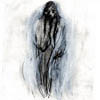 The already mysterious musical world of Loren Connors is made even more so by these recordings, finally unearthed after being lost for nearly 30 years. Of course the loss would not be nearly so poignant if it weren't for the fact that the recording shows Connors serenading the grave of Midnight Mary, the ghost of whom will apparently kill anyone who remains in the graveyard after midnight. While Connors clearly came out the other side alive, it does give these delta-drenched chants a certain weight as once more a bluesman—albeit a fairly loose interpretation of one—once more play games with the devil in search of musical ends. Keeping consistent with the folklore, it works yet again.
The already mysterious musical world of Loren Connors is made even more so by these recordings, finally unearthed after being lost for nearly 30 years. Of course the loss would not be nearly so poignant if it weren't for the fact that the recording shows Connors serenading the grave of Midnight Mary, the ghost of whom will apparently kill anyone who remains in the graveyard after midnight. While Connors clearly came out the other side alive, it does give these delta-drenched chants a certain weight as once more a bluesman—albeit a fairly loose interpretation of one—once more play games with the devil in search of musical ends. Keeping consistent with the folklore, it works yet again.
More importantly though, the album provides an early glimpse into the formative years of this modern guitar hero. Presented are nine tracks, all recorded to cassette on the same day in 1981, that see Connors mixing acoustic, delta-inspired guitar abstractions in duet with moaning vocal accompaniment. With only these two sound sources to work with, this is an intimate and haunting display of Connors' creativity within the blues medium, stretching Charley Patton's gospel vocals and Skip James' country blues style into his own collagist breakdown of the form.
As strange as his version of the blues may be though, Connors' play is steeped in tradition, as can be seen by numerous blues covers and allusions throughout. Twice, on "Chant 3" and "Chant 6," he stretches out on the themes of "Amazing Grace," infusing it with the deep gospel soul of its past while giving it an angular, exploratory quality too often lacking in covers of such well-known material. Rarely does the avant-garde so neatly coalesce with tradition without losing any of its soul.
Elsewhere on the disc, Connors calls upon any variety of influences, always handling them with aplomb and imbuing them with his own highly developed improvisational signature. Though often associated with a more folk-based (and seemingly classicist) tradition, Connors is an improviser at heart; barely able to read music, he has to be. With the same vigor that he would later bring to duo recordings with Jandek then, he croons and moans his way around these dark tunes with a loose and dissonant grace. The notes are important, sure, but what is ultimately more interesting is the proximity that Connors has to the guitar as an object; the sliding of his fingers, the banging of the wood, all add to the richness of these pieces.
Vocally too, Connors presents a highly elastic and deeply felt style that, while wordless, is never secondary to the guitar work here. Instead it moves around the thick chords and twanging runs, humming and vibrating in conjunction before breaking off to present some variant on the melody beneath the guitar's own distractions. While it may not be the kind of singing most often associated with the blues, there is a cathartic and spiritual quality here that is wholly Connors'. And ultimately, isn't that what good blues is all about anyway?
Special note too should be made that Connors presents a cryptic message on the back of the album, suggesting that no one listen to it due to the circumstances surrounding its recording and subsequent loss. Well I'm still here, and having survived the night, can safely say that music with this much life should never be missed for fear of some mysterious undoing.
Hope that doesn't jinx it for me...
samples:
Read More

